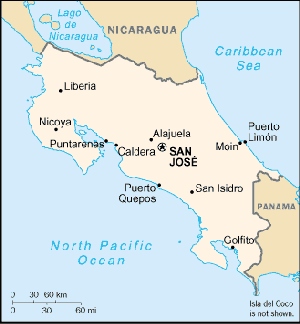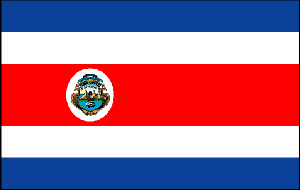
|
Costa-Rica
Background:
Costa Rica is a Central American success story: since the late 19th century,
only two brief periods of violence have marred its democratic development.
Although still a largely agricultural country, it has expanded its economy to
include strong technology and tourism sectors. The standard of living is
relatively high. Land ownership is widespread.
Location:
Middle America, bordering both the Caribbean Sea and the North Pacific Ocean,
between Nicaragua and Panama
Area: Total: 51,100 sq km, note: includes Isla del Coco, water: 440 sq km,
land: 50,660 sq km.
Area - comparative: Slightly smaller than West Virginia.
Land boundaries: Total: 639 km, border countries: Nicaragua 309 km, Panama 330
km.
Coastline: 1,290 km.
Climate and Terrain:
Climate: Tropical and subtropical; dry season (December to April); rainy season
(May to November); cooler in highlands.
Terrain: Coastal plains separated by rugged mountains.
Elevation extremes: Lowest point: Pacific Ocean 0 m, highest point: Cerro
Chirripo 3,810 m.
Natural resources: Hydropower.
People:
Population: 3,834,934.
Ethnic groups: White (including mestizo) 94%, black 3%, Amerindian 1%, Chinese
1%, other 1%.
Religions: Roman Catholic 76.3%, Evangelical 13.7%, other Protestant 0.7%,
Jehovah's Witnesses 1.3%, other 4.8%, none 3.2%.
Languages: Spanish (official), English spoken around Puerto Limon.
Government:
Government type: Democratic republic.
Capital: San Jose.
Independence: 15 September 1821 (from Spain).
Economy overview:
Costa Rica's basically stable economy depends on tourism, agriculture, and
electronics exports. Poverty has been substantially reduced over the past 15
years, and a strong social safety net has been put into place. Foreign
investors remain attracted by the country's political stability and high
education levels, and tourism continues to bring in foreign exchange. However,
traditional export sectors have not kept pace. Low coffee prices and an
overabundance of bananas have hurt the agricultural sector. The government
continues to grapple with its large deficit and massive internal debt and with
the need to modernize the state-owned electricity and telecommunications
sector.
GDP - composition by sector: Agriculture: 11%, industry: 37%, services: 52%.
Statistics:
Telephones - main lines in use: 450,000.
Telephones - mobile cellular: 143,000.
Radio broadcast stations: AM 50, FM 43.
Radios: 980,000.
Television broadcast stations: 6.
Televisions: 525,000.
Internet users: 250,000.
Railways: total: 950 km.
Highways: total: 37,273 km, paved: 7,827 km, unpaved: 29,446 km.
Airports: 152. with paved runways: 29, with unpaved runways: 123.
Return to Visiting Locations
|

